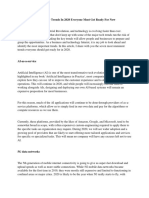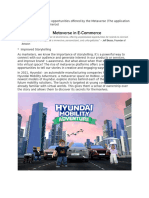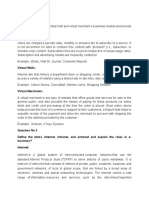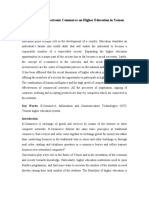0 ratings0% found this document useful (0 votes)
66 viewsTechnology Trends 2018
Technology Trends 2018
Uploaded by
gaurang jainThe document discusses several emerging technology trends in 2018 including blockchain, the internet of things, virtual reality, augmented reality, chatbots, and subscription business models. Blockchain allows for distributed but not copied digital information to create a new type of internet, while the internet of things connects physical objects to the internet. Virtual and augmented reality enhance user experiences by overlaying digital information on real environments. Chatbots use natural language processing to simulate conversations. Finally, the subscription model provides recurring revenue in exchange for ongoing access to goods and services.
Copyright:
© All Rights Reserved
Available Formats
Download as DOCX, PDF, TXT or read online from Scribd
Technology Trends 2018
Technology Trends 2018
Uploaded by
gaurang jain0 ratings0% found this document useful (0 votes)
66 views6 pagesThe document discusses several emerging technology trends in 2018 including blockchain, the internet of things, virtual reality, augmented reality, chatbots, and subscription business models. Blockchain allows for distributed but not copied digital information to create a new type of internet, while the internet of things connects physical objects to the internet. Virtual and augmented reality enhance user experiences by overlaying digital information on real environments. Chatbots use natural language processing to simulate conversations. Finally, the subscription model provides recurring revenue in exchange for ongoing access to goods and services.
Copyright
© © All Rights Reserved
Available Formats
DOCX, PDF, TXT or read online from Scribd
Share this document
Did you find this document useful?
Is this content inappropriate?
The document discusses several emerging technology trends in 2018 including blockchain, the internet of things, virtual reality, augmented reality, chatbots, and subscription business models. Blockchain allows for distributed but not copied digital information to create a new type of internet, while the internet of things connects physical objects to the internet. Virtual and augmented reality enhance user experiences by overlaying digital information on real environments. Chatbots use natural language processing to simulate conversations. Finally, the subscription model provides recurring revenue in exchange for ongoing access to goods and services.
Copyright:
© All Rights Reserved
Available Formats
Download as DOCX, PDF, TXT or read online from Scribd
Download as docx, pdf, or txt
0 ratings0% found this document useful (0 votes)
66 views6 pagesTechnology Trends 2018
Technology Trends 2018
Uploaded by
gaurang jainThe document discusses several emerging technology trends in 2018 including blockchain, the internet of things, virtual reality, augmented reality, chatbots, and subscription business models. Blockchain allows for distributed but not copied digital information to create a new type of internet, while the internet of things connects physical objects to the internet. Virtual and augmented reality enhance user experiences by overlaying digital information on real environments. Chatbots use natural language processing to simulate conversations. Finally, the subscription model provides recurring revenue in exchange for ongoing access to goods and services.
Copyright:
© All Rights Reserved
Available Formats
Download as DOCX, PDF, TXT or read online from Scribd
Download as docx, pdf, or txt
You are on page 1of 6
TECHNOLOGY TRENDS 2018
1. BLOCKCHAIN – By allowing digital information to distributed but not
copied, blockchain technology created the backbone of a new type of internet.
Originally devised as a digital currency, Bitcoin, the technology is now finding
other potential uses for the technology.
Bitcoin has been called “digital gold”, and for a good reason. To date, the total
value of the currency is close to $9 billion US. At a high level blockchain
technology of securely managing access and information. The core of blockchain
hinges around the idea of decentralization, which essentially distributes power
and risk equitably across the network.
Blockchain startups are finding niche and clever ways to optimize industries, by
replacing intermediary parties (brokers, agents, etc.) with smart contracts that
automatically verify actions without compromising data security. Platforms
like Gameflip and Filecoin are able to solve fundamental marketplace challenges,
worth billions of dollars, which have been terrorizing ecosystems for decades.
Other companies, like SparkleCoin, are driving blockchain adoption at scale by
empowering everyday consumers to purchase real-world products and services
from the world's largest online retailers using cryptocurrencies.
On the contrary, Ajay Banga, CEO of MasterCard said “I think cryptocurrency is
junk. The idea of ananonymised currency produced by people who have to mine
it, the value which can fluctuate wildly – that to me is not the way that any
medium of exchange deserves to be considered a medium of exchange.”
2. INTERNET OF THINGS - The internet of things (IoT) is a computing
concept that describes the idea of everyday physical objects being connected to
the internet and being able to identify themselves to other devices.
The IoT is significant because an object that can represent itself digitally
becomes something greater than the object by itself. No longer does the object
relate just to its user, but it is now connected to surrounding objects and
database data. When many objects act in unison, they are known as having
‘ambient intelligence’.
BI Intelligence's report on the "internet of things" notes that nearly $6 trillion will
be spent on IoT solutions in the next five years alone. This deluge of investment
has turned this once science-fictional notion into reality. Already there are ‘smart
beds’ to a Bluetooth connected alarm clock that communicates with our Wi-Fi
enabled speakers.
Various examples which come under IoT can be – Smart Home, Wearables,
Connected Cars, Industrial Internet, Smart Cities, Smart Farming, Smart Retail,
Smart Grids, Healthcare and Poultry.
3. VIRTUAL REALITY – It is an interactive computer-generated
experience taking place within a simulated environment, that incorporates mainly
auditory and visual, but also other types of sensory feedback like haptic.
While the technology is still evolving, and while players like Oculus and HTC
continue to iterate on their consoles, things look promising for the industry as VR
platforms begin to appeal to the masses.
One of the biggest obstacle for virtual reality achieving true scale is the creation
of enough content to attract wide swath of customers. As the industry has
learned, on boarding hard core gamers will not be enough to sustain long term
efforts.
To overcome this obstacle, virtual reality can lead to new and exciting
discoveries in these areas which impact our day to day lives. Wherever it is too
dangerous, expensive or impractical to do something in reality, virtual reality is
the answer. From trainee fighter pilots to medical application trainee surgeons,
virtual reality allows us to take virtual risks in order to gain real world experience.
As the cost of virtual reality goes down and it becomes more mainstream you can
expect more serious uses, such as educational or productivity applications.
Top examples of virtual reality can be – Volvo Reality, Matterport 3D Spaces,
Kings College London, Tribeca Immersive, BetterCloud VR Recruitment.
4. AUGMENTED REALITY – An enhanced version of reality live direct
or indirect views of physical real world environment are augmented with
superimposed computer generated images over a user’s view of the real world,
thus enhancing one’s current perception of reality.
Unlike virtual reality, which requires you to inhabit an entirely virtual environment,
augmented reality uses your existing environment and simply overlays virtual
information on top of it. As both virtual and real world environment harmoniously
coexist, users of augmented reality experience a new and natural world where
virtual information is used as a tool to provide assistance in everyday activities.
Applications of augmented reality can be as simple as a text notification or as
complicated as an instruction on how to perform a life threatening surgical
procedure. They can highlight certain features, enhance understandings, and
provide accessible and timely data. Cellphones apps and business application by
companies using augmented reality are a few of many applications driving
augmented reality application development. The key point is the information
provided is highly topical and relevant to what you want you are doing.
Few examples of augmented reality can be such as – Enhanced gaming
headwear, Military augmented reality (HUD, HMD), Medical augmented reality,
Visualizing possibilities and augmented reality in Sports.
5. CHATBOTS – also known as “conversational agents” – are software
applications that mimic written or spoken human speech for the purposes of
simulating a conversation or interaction with a real person. There are two primary
ways chatbots are offered to visitors: via web-based applications or standalone
apps. Today, chatbots are used most commonly in the customer service space,
assuming roles traditionally performed by living, breathing human beings such as
Tier-1 support operatives and customer satisfaction reps. Conversational agents
are becoming much more commonly partly due to the fact that barriers to entry in
creating chatbots (i.e. sophisticated programming knowledge and other highly
specialized technical skills) are becoming increasingly unnecessary. Today, you
can make your own chatbot that you can use in Facebook messenger, for
example – all without a pricey Computer Science degrees or much prior coding
experience – and there are several sites that offer the ability to create
rudimentary chatbots using simple drag-and-drop interfaces.
At the heart of a chatbot technology lies natural language processing or NLP, the
same technology that forms the basis of the voice recognition systems like virtual
assistants such as Google now, Apple’s Siri, Microsoft’s Cortona. Chatbots
process the text presented to them by user (a process known as “parsing”),
before responding to a complex series of algorithms that interprets and identifies
what the user said, infers what the mean and/or want, and determines a series of
appropriate responses based on the information. Some chatbots offer a
remarkably authentic conversational experience, in which it’s very difficult to
determine whether the agent is a bot or a human.
Most innovative examples for Chatbots can be such as – Endurance : A
companion for Dementia patients, Casper : helping insomniacs get through the
night (Insomnobot 3000), Disney : Solving crimes with fictional characters
(Zootopia), Marvel : Guardians of galaxy with comicbook crossover (very limited
chatbot), UNICEF : Helping developing nations speak out about the most urgent
needs in their community, MedWhat : making it easier for patients to
identify/detect illness, Roof Ai : helping real estate marketers generate leads,
NBC Politics : Helping navigate news faster.
6. SUBSCRIPTION MODEL – They are based on the idea of selling a
product or service to receive monthly or yearly recurring subscription revenue.
They focus on customer retention over customer acquisition. In essence,
subscription business model focus on the revenue is made so that a single
customer makes multiple payments for prolonged access to goods or services.
With the rise of technology and software as a service (SaaS) products, many
companies are moving from business revenue model where revenue is made
from a customer’s one time purchase to a subscription model where revenue is
made on a recurring basis in return for consistent access to the delivery of good
or service.
The easiest subscription model is to understand of a magazine company. Instead
of selling a magazine as a standalone product where the customer makes one-
time purchase, magazine companies offer subscription service for the delivery of
a weekly or monthly magazine. In this model, instead of customer making single
purchases, magazine company offer monthly payments for yearly subscription to
access their monthly magazines. If a magazine company offers monthly
magazine offers, instead of single magazine purchase, it offers a 12-month
service which comprises of 12 purchases. This makes the revenue model
stronger because if guarantees sales over a 12-month period rather than a single
purchase. This makes revenue forecasting and business planning easier, since a
company can project its sales farther out with more accuracy. Magazine
companies are not the only subscription business models. With technology,
almost any product or service can now be a subscription model.
The subscription e-commerce market has grown immensely where the largest
such retailers generated more than $2.6 billion in 2016, up from mere $57 million
in 2011. Fueled by venture capital investments, start-ups have launched these
business in wide range of categories, including beer and wine, child and baby
items, contact lenses, cosmetics, feminine products, meal kits, pet food, video
games and vitamins.
Here are examples of successful subscription sites – International living (daily
blogs with new photos and content from different parts of the world),
Copyblogger (content marketing site helping in generating leads), Blue Apron
(creates attention grabbing offers), Study Getaway (to know more about Bible to
get information they seek), Lynda.com (oldest online professional training site),
FabFitFun (helps women save on makeup), Youpreneur (helps work at home
entrepreneurs), Freelance Writers Den (coaching for writers), eHarmony (online
dating site), Dollar Shave Club (products for men), Pencil Kings (helps turn
dream of doing artwork into a career).
7. ELECTRONIC COMMERCE – ecommerce is a type of business
model, or segment of a larger business model, that enables a firm or an
individual to conduct business over electronic network, typically the internet.
Electronic commerce operates in all four major market segments: business to
business, business to consumer, consumer to consumer, consumer to business.
It can be thought of as a more advanced form of mail-order purchasing through a
catalog. Almost any product or service can be offered via ecommerce, from
books and music to financial services and plane tickets. Ecommerce has allowed
firms to enhance an existing market position, by providing cheaper and more
efficient distribution chain for their products or services.
When you purchase a good or service online, you are participating in
ecommerce. Advantages of ecommerce for a customer are convenience (it can
take place 24hours, seven days a week) and selection (wide array of products
online than they can find in a brick and mortar store). It also has some
disadvantages which are limited customer service, no instant gratification, no
ability to touch or see a product physically.
Top 10 biggest ecommerce retailers according to last year’s revenue are
Amazon ($94.6 billion), Apple ($16.8 billion), Walmart ($14.4 billion), Macy’s
($4.6 billion), Costco ($4.2 billion), QVC ($4 billion), Nordstorm ($3.2 billion),
Target ($3 billion), Kohl’s ($3 billion), Gap ($2.5 billion).
8. AUTOMATION – It is the creation of technology and its application in
order to control and monitor the production and delivery of various goods and
services. It performs tasks that were previously performed by humans.
Automation is being used in a number of areas such as manufacturing, transport,
utilities, defense, facilities, operations and lately, information technology
The top 6 AI technologies that will have an impact on jobs-positive and negative-
in near future are Customer Self-Service, AI-Assisted Robotic Process
Automation, Industrial Robots, Retail and Warehousing Robots, Virtual
Assistants, Sensory AI.
Customer self-service refers to customer-initiated interaction technologies that
enable customer to access information and perform routinely tasks without
requiring a customer service representative. Vendor examples can be Fujitsu,
Kiosk Information Systems, NCR, Samsung.
Robotic Process Automation is that allows anyone today to configure computer
software, or a “robot” to integrate and emulate the actions of humans interacting
with digital systems to execute a business process. RPA robots utilize the user
interface to capture data and manipulate applications just like humans do.
Vendor examples can be Automation Anywhere, BluePrism, UiPath.
Industrial Robots are physical robots that execute task in manufacturing,
construction, agriculture, and similar verticals with heavy industrial-scale
workloads. Vendor examples can be Kawasaki, Mitsubishi, Blue River
Technology, Aethon.
Retail and Warehousing robots with autonomous capabilities used in retail and/or
warehousing. Vendor examples can be Amazon Kiva Systems, Fetch Robotics,
Locus Robotics.
Virtual Assistants are personal digital concierges that know users and their data
and are discerning enough to interpret their needs and make decisions on their
behalf. Vendor examples can be Amazon Alexa, Apple Siri, Microsoft Cortona.
Sensory AI are improving computers ability to identify, understand and even
express human sensory faculties and emotions via images, video analysis, facial
recognition, speech analytics, and/or text analytics. Vendor examples can be
Amazon Lex, Google Cloud Platform, Amazon Rekognition, Aurora Computer
Services.
You might also like
- Transforming The Customer Experience Through New TechnologiesDocument15 pagesTransforming The Customer Experience Through New TechnologieswanNo ratings yet
- Netflix Premium Cookie 6Document2 pagesNetflix Premium Cookie 6Venky Max100% (1)
- A Detailed Study On E - Payment Modes and Its ImpactDocument53 pagesA Detailed Study On E - Payment Modes and Its ImpactSatyan100% (1)
- IoT and Marketing June 23Document8 pagesIoT and Marketing June 23Tomy1969No ratings yet
- Gartner's Top 10 Strategic Technology Trends For 2017Document7 pagesGartner's Top 10 Strategic Technology Trends For 2017Yusuf KusumaNo ratings yet
- 16 Digital TrendsDocument37 pages16 Digital TrendsprogrambipNo ratings yet
- Final ExamDocument5 pagesFinal ExamMartaNo ratings yet
- Computer Science Business Problems Lecture1Document40 pagesComputer Science Business Problems Lecture1k226018 Sarah AhmedNo ratings yet
- Artificial Intelligence Marketing: ChatbotsDocument4 pagesArtificial Intelligence Marketing: ChatbotsNandhiniNo ratings yet
- Emerging TechnologyTrends Digital ASinha Feb2018 Draft v1Document14 pagesEmerging TechnologyTrends Digital ASinha Feb2018 Draft v1AmitNo ratings yet
- Module 11Document7 pagesModule 11Saidatul Rashida SULTANNo ratings yet
- Components? ExplanationDocument14 pagesComponents? ExplanationAntush TesfayeNo ratings yet
- Social, Mobile & The Cloud: Complex Nature of Technology or An Opportunity For Better Business?Document9 pagesSocial, Mobile & The Cloud: Complex Nature of Technology or An Opportunity For Better Business?Sunilms09No ratings yet
- Current and Future Trends in Media and Information GROUP 2Document21 pagesCurrent and Future Trends in Media and Information GROUP 2JENNY ROSE PANGDAONo ratings yet
- Chatbot White PaperDocument10 pagesChatbot White PaperVignesh GangulyNo ratings yet
- CB2500 Information Management TutorialDocument5 pagesCB2500 Information Management TutorialKim SuenNo ratings yet
- 2893Document2 pages2893sahilbarbade.ee101No ratings yet
- Abeni EmergDocument8 pagesAbeni Emergfasilmengesha79No ratings yet
- Current Issue Fintech-2020Document30 pagesCurrent Issue Fintech-2020Raudah YamnaNo ratings yet
- Current Future Trends of Media and InformationDocument2 pagesCurrent Future Trends of Media and InformationRichbel Orjohn OrhinNo ratings yet
- ResearchDocument41 pagesResearchPriyanshu RawatNo ratings yet
- Assignment PBMDocument10 pagesAssignment PBMABHISHEK SINGHNo ratings yet
- Automating TrustDocument9 pagesAutomating TrustEsperanza OrregoNo ratings yet
- 3MGTG Up Front and Personal ReportDocument48 pages3MGTG Up Front and Personal ReportbinkomerNo ratings yet
- Digital Marketing AssignmentDocument8 pagesDigital Marketing AssignmentOlivia SandyNo ratings yet
- Being Digital: Making Digital Real and RewardingDocument13 pagesBeing Digital: Making Digital Real and RewardingCognizantNo ratings yet
- TenBillion Coin White Paper 20190717Document24 pagesTenBillion Coin White Paper 20190717rctg12No ratings yet
- Bba LRE NotesDocument24 pagesBba LRE NotesSreeranjPrakashNo ratings yet
- Revolutionising The Customer ExperienceDocument9 pagesRevolutionising The Customer Experiencelinda.hendricks.seNo ratings yet
- 9 Disruptive Technology Trends For 2019 - Disruption HubDocument9 pages9 Disruptive Technology Trends For 2019 - Disruption HubRahul DevNo ratings yet
- Artificial Intelligence Privacy and EthicsDocument6 pagesArtificial Intelligence Privacy and EthicsAndrew OltonNo ratings yet
- Quantum Entrepreneurship: ChatGPT, Ethical Hacking, and the Future of Remote BusinessFrom EverandQuantum Entrepreneurship: ChatGPT, Ethical Hacking, and the Future of Remote BusinessNo ratings yet
- FutureofRetailTouchpoints FINALDocument13 pagesFutureofRetailTouchpoints FINALHirva Trivedi VarmaNo ratings yet
- The 7 Biggest Technology Trends in 2020 Everyone Must Get Ready For NowDocument5 pagesThe 7 Biggest Technology Trends in 2020 Everyone Must Get Ready For NowKimberly Sharah Mae FortunoNo ratings yet
- Tech & Me Transcript: Why The Internet of Things MattersDocument18 pagesTech & Me Transcript: Why The Internet of Things MattersferminNo ratings yet
- 10 Trends Digital MediaDocument4 pages10 Trends Digital MediaSudhan DeoNo ratings yet
- Q2 Mil Module Week 3Document13 pagesQ2 Mil Module Week 3EL EM TINo ratings yet
- The Corporate Hitchhikers Guide To The Metaverse Apr 2022 RDocument20 pagesThe Corporate Hitchhikers Guide To The Metaverse Apr 2022 RVictor ValenteNo ratings yet
- Final International Relationship Management ReportDocument13 pagesFinal International Relationship Management ReportBradley PaceNo ratings yet
- Module 11 Essential Digital SkillsDocument102 pagesModule 11 Essential Digital SkillsJohn PhilipNo ratings yet
- Impact AI Chatbot Disclosure Customer PurchasesDocument12 pagesImpact AI Chatbot Disclosure Customer PurchasesKeshavvardhan DNo ratings yet
- Module 9 - Trends in ITDocument11 pagesModule 9 - Trends in ITANHIBEY, JEZREEL ACE S.No ratings yet
- 3d InternetDocument18 pages3d InternetMukesh Muralidharan NambiarNo ratings yet
- FintechDocument18 pagesFintechDIVYANo ratings yet
- Company Using It and To Its Business CustomersDocument5 pagesCompany Using It and To Its Business CustomersEnamNo ratings yet
- Artificial Intelligence and Digital BankingDocument16 pagesArtificial Intelligence and Digital BankingAbhijeet AnandNo ratings yet
- AI by tajinder singh ggsipuDocument11 pagesAI by tajinder singh ggsipuhelpdesksatguruNo ratings yet
- Current and Future TrendsDocument15 pagesCurrent and Future TrendsJacquinNo ratings yet
- Iot ReviewerDocument9 pagesIot Reviewerdelapena.kategabrielle.cNo ratings yet
- Current and Future Trends in Media and InformationDocument40 pagesCurrent and Future Trends in Media and InformationJohn Terry LimNo ratings yet
- TOP 10: Principales Tendencias Comerciales Que Te Llevaran Al Éxito en 2018Document3 pagesTOP 10: Principales Tendencias Comerciales Que Te Llevaran Al Éxito en 2018Sombre CÿrNo ratings yet
- MetaverseDocument4 pagesMetaversenguyencamnhung11012005No ratings yet
- Gartner Top 10 Strategic Technology Trends For 2019: and Its Reflection On: Software Testing, Cloud ComputingDocument11 pagesGartner Top 10 Strategic Technology Trends For 2019: and Its Reflection On: Software Testing, Cloud ComputingRadwa.mansourNo ratings yet
- Notes For The ClassDocument25 pagesNotes For The ClassgopiNo ratings yet
- McKinsey. Analytics Comes of Age. March 2018 PDFDocument100 pagesMcKinsey. Analytics Comes of Age. March 2018 PDFgcvela100% (1)
- Latest Information Technology Trends 2023Document5 pagesLatest Information Technology Trends 2023Salveigh C. TacleonNo ratings yet
- Current Trends and Emerging TechnologiesDocument7 pagesCurrent Trends and Emerging TechnologiesSJAY GAOAT100% (2)
- AnyWeb - Trends 2024 - Which Technology Will Most Revolutionize Our FutureDocument16 pagesAnyWeb - Trends 2024 - Which Technology Will Most Revolutionize Our Futurebp6tjgxs4jNo ratings yet
- Internet of Things For MarketersDocument19 pagesInternet of Things For MarketersdeltonbaiduNo ratings yet
- AyazDocument5 pagesAyazumair ijazNo ratings yet
- Factors of Doing Business in BangladeshDocument49 pagesFactors of Doing Business in BangladeshAsif Rahman100% (2)
- Concepts of CryptographyDocument15 pagesConcepts of Cryptographysumit2k4No ratings yet
- GST Registration in IndiaDocument24 pagesGST Registration in IndiaVijai AnandNo ratings yet
- E-Business Revenue ModelsDocument40 pagesE-Business Revenue ModelsRafiqul Islam NoyonNo ratings yet
- BBM 7th Sem Syllabus 2016 PDFDocument23 pagesBBM 7th Sem Syllabus 2016 PDFBhuwan100% (1)
- Adidas FinalDocument39 pagesAdidas Finalgulshan0% (1)
- Quickheal AnnualreportDocument229 pagesQuickheal AnnualreportPiyush HarlalkaNo ratings yet
- Web Site Name Web Site URL Subject Area/ Topic Page Rank: Licon Beach TrainingDocument13 pagesWeb Site Name Web Site URL Subject Area/ Topic Page Rank: Licon Beach TrainingKriistiina NittoheiNo ratings yet
- The Impact of Electronic Commerce On Higher Education in YemenDocument5 pagesThe Impact of Electronic Commerce On Higher Education in YemenERP AdministratorNo ratings yet
- Colgate Palmolive MIS ReportDocument5 pagesColgate Palmolive MIS ReportahsnkhwajaNo ratings yet
- CPSPM 26674466 1717144696Document26 pagesCPSPM 26674466 1717144696saranbayireddy69No ratings yet
- Fundraising PresentationDocument18 pagesFundraising Presentationpushkar royNo ratings yet
- TOC - Consumer Electronics in VietnamDocument7 pagesTOC - Consumer Electronics in VietnamLinh TranNo ratings yet
- Online Shopping Documentation SRSDocument168 pagesOnline Shopping Documentation SRSAbhijeet SawantNo ratings yet
- Retail and EcommerceDocument33 pagesRetail and EcommerceDurgesh MishraNo ratings yet
- Chapter-7 E-ProcurementDocument23 pagesChapter-7 E-ProcurementTisaNo ratings yet
- Credit Card FraudDocument13 pagesCredit Card Frauda2zconsultantsjprNo ratings yet
- Set Up Public-Key Authentication Between An OpenSSH Client and An OpenSSH ServerDocument3 pagesSet Up Public-Key Authentication Between An OpenSSH Client and An OpenSSH ServerLucian Taranu-TudorNo ratings yet
- E-Commerce: Security Challenges and SolutionsDocument37 pagesE-Commerce: Security Challenges and Solutionsvaibhav guptaNo ratings yet
- Sample Thesis of Online Ordering SystemDocument6 pagesSample Thesis of Online Ordering Systembsdy1xsd100% (2)
- MFS in BangladeshDocument40 pagesMFS in BangladeshSadat Riddho ChowdhuryNo ratings yet
- Adobe Scan Mar 29, 2024Document1 pageAdobe Scan Mar 29, 2024Varun TungriaNo ratings yet
- Overview of Electronic CommerceDocument16 pagesOverview of Electronic Commerceasma246No ratings yet
- The Important Details of Windows AuthenticationDocument34 pagesThe Important Details of Windows AuthenticationletumarNo ratings yet
- Big Data Dissertation DikshaDocument8 pagesBig Data Dissertation DikshaAbhipriyo BanerjeeNo ratings yet
- E ChequeDocument5 pagesE ChequeKaustubh ShilkarNo ratings yet
- Beginner Forex MasteryDocument1 pageBeginner Forex MasteryReagan KatendeNo ratings yet
- BCG Internet ReportDocument32 pagesBCG Internet ReportMorning FlowerNo ratings yet

























































































